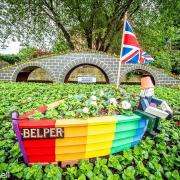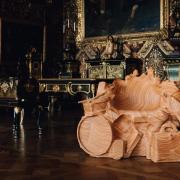Peter Seddon continues his Derbyshire monuments trail with ‘Ashbourne’s Golden Lady’ Catherine Booth
In 1922 Ashbourne honoured the World War One fallen by creating the town’s Memorial Gardens. Today the well-tended park extends that same respect to later conflicts – a place for quiet reflection away from the bustling centre.
Prominent atop a verdant rise is the striking head and shoulders likeness of Catherine Booth (1829-1890) – who with her husband General William Booth (1829-1912) co-founded the Salvation Army.
A plaque below the gleaming bust elucidates Ashbourne’s link – ‘The Army Mother’ was born there. Yet so much remains unsaid – Catherine’s remarkable life fills volumes. Likewise that of her beloved William – his own Derbyshire ancestry makes him almost a native too.
She was born Catherine Mumford at 13 Sturston Lane (now Road), Ashbourne, on 17th January 1829, and baptised in Derby. Her parents were Ticknall-born John Mumford and his wife Sarah Milward, an Ashbourne girl. Catherine’s humble birthplace is marked by a simple tablet placed above its door in 1946.
Her wheelwright father John also practised as a Methodist lay preacher – mother Sarah shared his faith. Catherine was raised according to firm religious strictures – a studious thinker said to have read The Bible eight times all through before she was twelve.
Her mother became her main influence, educating Catherine at home to a standard ‘beyond her years’ and instilling strict values. Even before her teens Catherine condemned ‘the evil drink’, fervently urging the abstinence which would become a mainstay of the Salvation Army doctrine.
Catherine left Ashbourne at the age of five. In 1834 the family moved to Boston, Lincolnshire. In 1844 they relocated to Brixton in London. By then the ‘good girl’ had become a ‘fine young lady’ – a committed Christian with a strong sense of social justice and a burning desire to ‘save souls’.
Catherine also developed strong feminist convictions, in particular espousing the cause of ‘women as preachers’ in a Victorian society where religious oratory was still considered a male province. Although sometimes portrayed as ‘old-fashioned’ Catherine Mumford was in essence a woman well ahead of her time. While never attaining the same degree of ‘liberation’ as more recent generations, some of her progressive views still resonate.
In 1852 she became engaged to Methodist minister William Booth – his powerful preaching in London had much impressed her. The kindred spirits married on 16th June 1855 – both aged 26 and possessed of a fiery zeal to ‘rescue’ and then ‘convert’. Overcoming prejudices, Catherine became a preacher in the Methodist Church and was soon recognised as an exceptional speaker. The couple settled in London’s East End, gradually garnering a reputation in their fight against poverty and injustice. Allying ‘political principles’ to their Christian beliefs they created a burgeoning ‘movement for change’.
In 1865 they began the East London Christian Mission which in 1878 was re-named The Salvation Army. In its early years it encountered considerable opposition – followers were labelled ‘do-gooders’, and the founders accused of misusing funds for their own ‘cultish ends’. A newspaper observed that a Salvationist assembly in Derby ‘provoked disorderly scenes which almost assumed the proportions of a riot’.
But the movement gradually acquired recognition, prospered and earned respect. Catherine and William worked tirelessly for the cause – at the same time raising nine children.
The devoted pair shared Derbyshire roots. William was born in Sneinton, Nottingham, to Samuel Booth and his second wife Mary Moss. But in an article for All The World magazine he revealed his lineage: ‘Both my parents were Derbyshire people. My father was born at Belper and my mother at Somercotes.’
From small beginnings Samuel Booth had become a wealthy ‘property developer’ – progressively ‘nailer’, builder, architect and gentleman. He left Belper for a fine residence in Colston Bassett, Nottinghamshire, but ruined himself by disastrous speculations. By the time his son William was born in 1829 the family had moved to Sneinton in much-straitened circumstances. Samuel sought solace in drink and by 1842 was declared bankrupt, dying soon afterwards.
William Booth was then just 14. Witnessing his father’s sorry demise proved the catalyst for his own philosophy. He later wrote: ‘My father was a “Grab man” only interested in money. He lived without God. And he died miserably. I became a Grab man too – but I grabbed fallen souls.’
Catherine and William remained proud of their Derbyshire connections. Their son William Bramwell Booth wrote: ‘They always reserved a warm corner in their hearts for Derbyshire and visited it more often than perhaps any other county. My mother truly venerated her Ashbourne birthplace.’
Catherine Booth developed cancer in her late fifties. Although moving to Clacton-on-Sea for recuperation she lost her battle. She died there aged 61 on 4th October 1890 – in Salvation Army parlance ‘Promoted to Glory’. William Booth died in London on 20th August 1912 aged 83. Both funerals were held in the capital, attended by countless thousands.
The Catherine Booth bust in Ashbourne was unveiled on Easter Sunday 1962 – created by the Morris Art Bronze Foundry of London. The company was chosen because in 1929 it had cast full-length statues for London of both William and Catherine by sculptor George Edward Wade (1853-1933) – the Ashbourne bust appears to be broadly modelled on Wade’s original.
Close scrutiny reveals it to be ‘coated’ in a plastic-type finish – not solid bronze as might first appear. No matter – its radiance is striking, a shining tribute. Some have said that Catherine appears ‘severe’ – but ‘serene’ would be a better word. From beneath her trademark bonnet the ‘Golden Lady’ of Ashbourne surveys the scene with a calm assurance that suggests her work is done.
Today the Salvation Army is a Christian church and charity with 1.5 million members and a presence in 127 countries. Under the mission statement ‘Transforming Lives in Every Country’ it continues the broad spectrum of ‘good works’ which William and Catherine Booth so ably started.



























